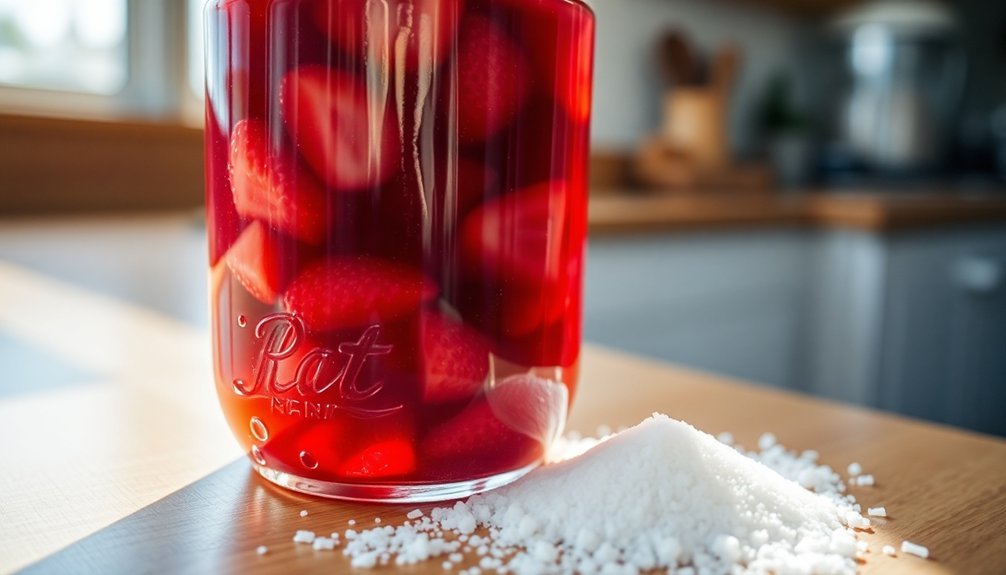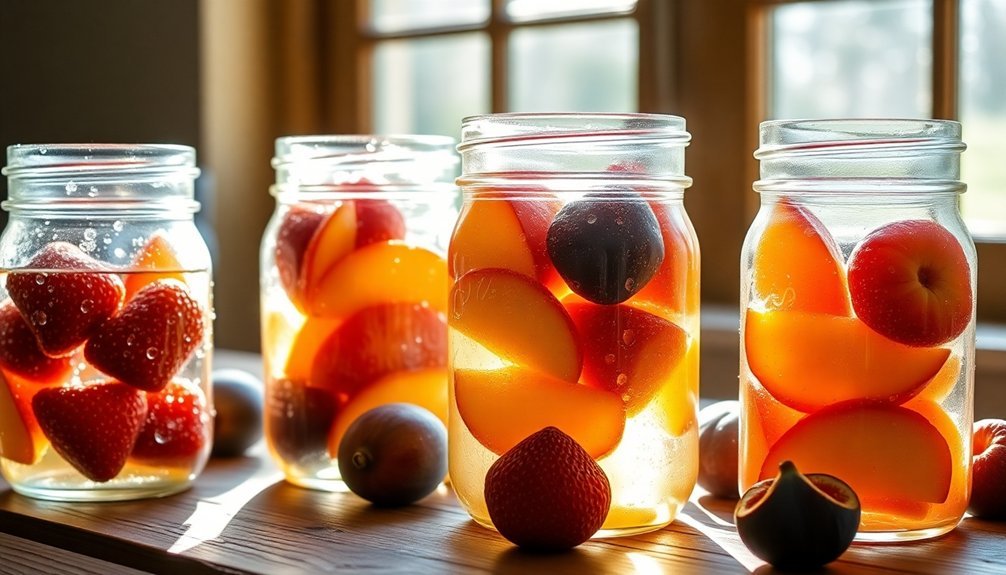You'll find five powerful sugar preservation methods to extend your food's shelf life naturally. Start with crystalline sugar packing by storing dry foods in airtight containers with rice to prevent moisture. Try sugar syrup immersion enhanced with citric acid for fruits and vegetables. Use honey's natural antibacterial properties to preserve fruits through osmosis. Harness fermentation with sugar to create probiotic-rich preserved foods. Master the jam-making process by combining fruit with sugar at precise temperatures. These time-tested techniques offer different approaches to food preservation, and each method brings its own unique benefits to your preservation toolkit.
Crystalline Sugar Packing Method
Getting your crystalline sugar properly packed starts with selecting the right storage container. You'll want to choose opaque, airtight options that protect against moisture and odors. Your best choices include food-grade plastic buckets, glass canning jars, #10 cans, or high-quality polyethylene and Mylar-type bags.
Don't use retail paper packages or metal containers, as they won't provide adequate protection for long-term storage.
When you're packing your sugar, make sure it's stored in a cool, dry location away from the refrigerator. You'll need to prevent any moisture exposure, as this can cause your granulated sugar to become hard and lumpy – a condition that can't be reversed. Adding a few grains of dry white rice can help absorb excess moisture in the container.
Place your containers in an odor-free area since sugar readily absorbs surrounding smells.
The sugar you're storing has gone through a specific crystallization process in vacuum pans, where seed grain serves as a nucleus for crystal formation. The resulting crystals are separated from molasses, washed, and graded by size.
This crystalline structure is what makes sugar an effective preservative, as it creates a low water activity environment that inhibits microbial growth in foods.
Sugar Syrup Immersion
You can enhance your syrup's preservation power by adding citric acid or using a combination of potassium sorbate and sodium benzoate.
The process reduces water activity in foods, making them resistant to spoilage.
Store your finished products in glass canning jars or #10 cans, keeping them in a cool, dry place to prevent crystallization.
If your syrup does crystallize, you can easily fix it by placing the container in hot water until the crystals dissolve.
Remember to record the amount of sugar you've used, as you'll need this information for future recipes.
Honey Based Preservation
Understanding honey's preservative power starts with its remarkable ability to dehydrate microorganisms through osmosis. The high sugar concentration pulls water from bacteria and yeast cells, creating an environment where microbes can't survive. You'll find honey's low moisture content and slightly acidic nature work together to provide excellent preservation capabilities. Natural antioxidants present in honey help protect preserved foods from oxidation and spoilage.
For short-term preservation, you can refrigerate fruits directly in honey. Simply cover your fruits completely in a jar of honey and store them for up to two weeks. For long-term storage, you'll need to create a honey syrup suitable for hot water bath canning, combining honey, sugar, and water to achieve proper consistency and pH levels.
| Storage Method | Duration | Processing | Container Type |
|---|---|---|---|
| Direct Honey | 2 weeks | None required | Glass jar |
| Honey Syrup | Months | Hot water bath | Mason jar |
| Refrigerated | 2-3 weeks | None required | Airtight container |
| Canned | 12+ months | Water bath canning | Canning jar |
Store your honey-preserved foods in airtight containers in cool, dry locations. If crystallization occurs, you can restore honey's liquid state by placing the container in hot water. Remember to avoid mixing honey with high-moisture foods without proper processing to maintain its preservative effectiveness.
Fermentation With Sugar
Three key processes define sugar-based fermentation: microbial activity, sugar conversion, and acid production.
When you ferment foods, beneficial bacteria and yeasts break down the sugars present in your ingredients, creating preservative compounds like lactic acid or ethanol. This process occurs in an oxygen-free environment, where the microorganisms thrive and transform your food into a preserved state.
You'll find that sugar plays an essential role in successful fermentation, as it provides the necessary food for beneficial bacteria. The resulting acidic environment helps prevent harmful bacteria from growing, effectively preserving your food for longer periods.
This natural preservation method not only extends shelf life but also enhances nutritional value.
- Start with high-sugar content foods like cabbage for sauerkraut, milk for yogurt, or fruits for pickles
- Maintain proper temperature and pH levels in your fermentation containers
- Use airtight containers to create the necessary anaerobic environment
- Wait for the fermentation process to complete, indicated by a tangy flavor and preserved texture
Through fermentation, you're creating nutrient-rich foods with enhanced flavors while ensuring they'll stay fresh longer.
Fruit Jam Making Process

While fermentation harnesses sugar's preservative properties through bacterial action, making fruit jam relies on sugar's direct role in preservation through heat and concentration. You'll need to start by inspecting and washing your fruit thoroughly, then peeling and chopping it before blending to the desired consistency. Once you've prepared your fruit mixture, you'll add sugar and bring it to a boil while maintaining a temperature of 105°C.
| Step | Key Action |
|---|---|
| Preparation | Wash, peel, and chop fruit |
| Mixing | Combine fruit with sugar |
| Boiling | Heat to 105°C, remove foam |
| Testing | Perform sheet test for consistency |
| Packaging | Fill sterilized jars, seal properly |
During the boiling process, you'll need to remove any foam that forms on the surface, and you can add citric acid to help with setting. To test if your jam is ready, conduct a sheet test by dropping some from a spoon – it should hold its shape. Once you've achieved the proper consistency, let the mixture cool before filling it into sterilized jars. Make sure you're using clean, properly sealed containers and store them in a cool, dry place for ideal preservation.
Frequently Asked Questions
Can Sugar Preservation Methods Be Used With Vegetables and Herbs?
Yes, you can effectively preserve vegetables and herbs using sugar. It works by drawing out moisture through osmosis, which prevents microbial growth. You'll find it especially useful for making herbal sugars and candied vegetables.
Does the Type of Sugar Used Affect the Preservation Quality?
Yes, your choice of sugar matters. You'll get the best preservation using granulated white sugar, while brown sugar or raw sugars can affect color and flavor, potentially reducing shelf life and preservation quality.
How Long Can Foods Preserved With Sugar Last at Room Temperature?
If you've properly preserved food with sugar, it can last indefinitely at room temperature. You'll find it stays safe to eat for years, though you might notice some quality changes after about 2 years.
Are There Health Concerns Associated With Consuming Sugar-Preserved Foods Regularly?
You should be cautious about regularly eating sugar-preserved foods as they're high in added sugars, which can increase your risk of obesity, diabetes, heart disease, and other health issues over time.
What Are Signs That Sugar-Preserved Foods Have Gone Bad?
You'll know your sugar-preserved foods have spoiled if you notice mold growth, slimy texture, unusual colors, sour smells, bubbling, or bulging lids. Don't consume anything that seems off or suspicious.
In Summary
You've now learned five effective ways to preserve food using sugar. Whether you're packing fruits in crystalline sugar, immersing them in syrup, using honey's natural properties, fermenting with sugar, or making homemade jams, these methods will help extend your food's shelf life. Start with small batches to perfect your technique, and you'll soon be preserving seasonal produce like a pro.





Leave a Reply